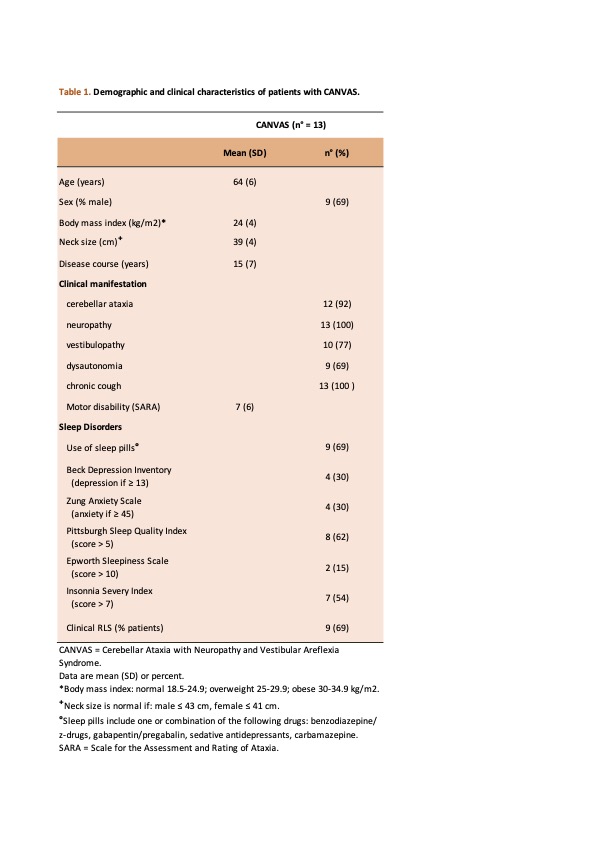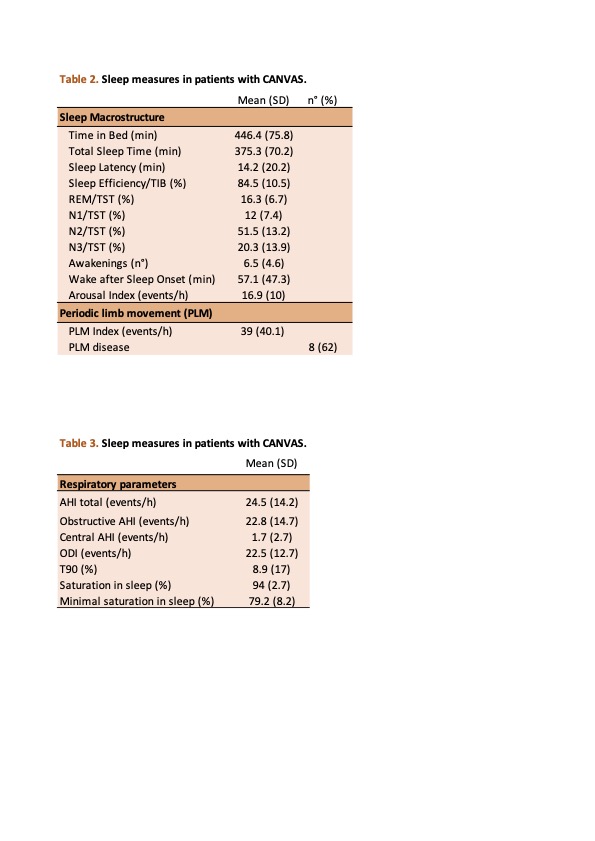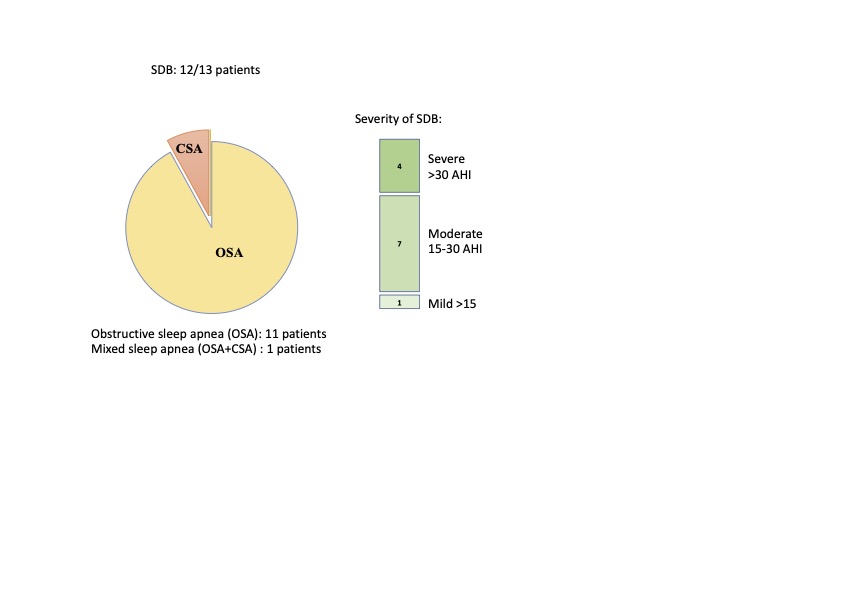Category: Ataxia
Objective: Aim in this study is to characterize, for the first time, sleep and its disorders in patients with CANVAS genetically confirmed.
Background: Cerebellar ataxia, neuropathy and vestibular areflexia syndrome (CANVAS) is a recessive late-onset ataxia caused by biallelic AAGGG expansions in the second intron of replication factor complex subunit 1 (RFC1) gene (1). Despite the phenotypic spectrum associated by RFC1 mutation is broad (2), dates on sleep disorders have not been collected.
Method: Sleep quality, daytime sleepiness and insomnia were assessed by means of self-administered questionnaires. The restless leg syndrome (RLS) was investigated with the administration of IRLS diagnostic clinical interview. The sleep macrostructure and presence of rapid eye movement (REM) without atonia and periodic legs movements (PLM) were evaluated by polysomnography (PSG).
Results: Thirteen patients with genetically confirmed CANVAS were enrolled (9 males, mean age: 64 ±7.3 years) with an average duration of disease of 15 ±7 years. Sensory axonal polyneuropathy and chronic spasmodic cough were present in all patients. Dysautonomia and vestibulopathy was reported in 9 and 10 patients, respectively. The subjective sleep assessment, 8 patients complained poor sleep quality, 2 complained daytime sleepiness, 7 patients reported insomnia symptoms, 9 patients met the diagnostic criteria from moderate to very severe RLS. PSG results showed a normal sleep efficiency (sleep efficiency/TIB: 84.5 ±10.5%), but an elevated number of sleep awakenings (number of awakenings: 6.5 ±4.6) with an increased wake after sleep onset (WASO: 57 ±47 minutes). REM without atonia was present only 1 patient. PLM was observed in 8 patients. Obstructive sleep apnea (OSA) was present in 12 (92%) patients, ranging from moderate to severe (mean AHI total: 24.5 ±14), 1 of which also showed significant number of central sleep apnea. The one patient without sleep-disorder breathing had a shorter disease duration.
Conclusion: Our data showed that patients with CANVAS have middle insomnia, poor sleep quality and a high prevalence of sleep disorders. OSA is the most common disorder, although daytime sleepiness was poorly reported. Likely, high prevalence of OSA is partly caused by vagus nerve impairment. Moreover, PLM and RLS are similarly common in this population. Therefore, given the high prevalence of sleep disturbances, sleep assessment should be routinely performed in patients with CANVAS.
Table 1. Demographic and clinical characteristics.
Table 2. Sleep measures. Table 3. Sleep measures.
Fig 1. Sleep disordered breathing (SDB).
References: 1) Cortese A, Curro’ R, Vegezzi E, Yau WY, Houlden H, Reilly MM. Cerebellar ataxia, neuropathy and vestibular areflexia syndrome (CANVAS): genetic and clinical aspects. Pract Neurol. 2022 Feb;22(1):14-18. doi: 10.1136/practneurol-2020-002822. Epub 2021 Aug 13. PMID: 34389644.
2) Cortese A, Reilly MM, Houlden H. RFC1 CANVAS / Spectrum Disorder. 2020 Nov 25. In: Adam MP, Feldman J, Mirzaa GM, Pagon RA, Wallace SE, Bean LJH, Gripp KW, Amemiya A, editors. GeneReviews® [Internet]. Seattle (WA): University of Washington, Seattle; 1993–2024. PMID: 33237689.
To cite this abstract in AMA style:
A. Funcis, G. Dalla Zanna, S. Rossi, F. Madia, G. Silvestri, V. Brunetti. CANVAS and Sleep Disorder: a Prospective Cross-Sectional Study [abstract]. Mov Disord. 2024; 39 (suppl 1). https://www.mdsabstracts.org/abstract/canvas-and-sleep-disorder-a-prospective-cross-sectional-study/. Accessed December 29, 2025.« Back to 2024 International Congress
MDS Abstracts - https://www.mdsabstracts.org/abstract/canvas-and-sleep-disorder-a-prospective-cross-sectional-study/



